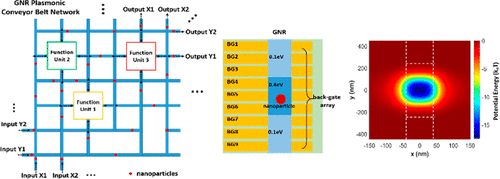当前位置:
X-MOL 学术
›
ACS Photonics
›
论文详情
Our official English website, www.x-mol.net, welcomes your
feedback! (Note: you will need to create a separate account there.)
Graphene Nanoribbon Plasmonic Conveyor Belt Network for Optical Trapping and Transportation of Nanoparticles
ACS Photonics ( IF 6.5 ) Pub Date : 2020-11-10 , DOI: 10.1021/acsphotonics.0c01353 Peter Qiang Liu 1 , Puspita Paul 1
ACS Photonics ( IF 6.5 ) Pub Date : 2020-11-10 , DOI: 10.1021/acsphotonics.0c01353 Peter Qiang Liu 1 , Puspita Paul 1
Affiliation

|
Optical tweezers based on metallic plasmonic structures can achieve stable trapping of objects with deep subwavelength dimensions. However, due to the lack of real-time tunability of metallic plasmonic structures, manipulating trapped objects is challenging and usually requires sophisticated tuning of the excitation light source, which limits the application scope of such plasmonic tweezers. Here, we propose the operation principle and analyze the performance of a two-dimensional (2D) network of plasmonic conveyor belts employing electrically tunable graphene plasmonic structures, which can simultaneously and independently trap and transport multiple nanoparticles to arbitrary target locations within the network. Transportation of nanoparticles is achieved by dynamically reconfiguring the carrier density distribution in a graphene nanoribbon based network structure using an array of back-gates, without a need for any change to the excitation light source. Our numerical analyses show that relatively large optical forces can be induced on nanoparticles with tens of nm characteristic dimensions at a moderate excitation source intensity (e.g., 1 mW/μm2), and the corresponding trapping potential energy exceeds 10 kBT at room temperature, which guarantees stable trapping during nanoparticle manipulation. Suitable designs of the junction structures in the network are developed, and effective schemes for all-directional routing of nanoparticles at these junctions are proposed and quantitatively analyzed. Such graphene-based plasmonic conveyor belt networks have high design flexibility and system scalability and, therefore, may find a wide range of applications in different areas such as lab-on-a-chip, assembling complex nanostructures and devices, studying many-body physics, and advancing quantum information technologies.
中文翻译:

石墨烯纳米带等离子输送带网络用于光学捕集和运输纳米颗粒。
基于金属等离子体结构的光镊可以稳定捕获深亚波长尺寸的物体。然而,由于缺乏金属等离激元结构的实时可调谐性,操纵捕获的物体具有挑战性,并且通常需要对激发光源进行复杂的调谐,这限制了这种等离激元镊子的应用范围。在这里,我们提出了工作原理并分析了采用电可调石墨烯等离激元结构的等离激元输送带的二维(2D)网络的性能,该结构可以同时且独立地将多个纳米粒子捕获并运输到网络内的任意目标位置。通过使用背栅阵列在基于石墨烯纳米带的网络结构中动态重新配置载流子密度分布,而不需要对激发光源进行任何更改,即可实现纳米颗粒的运输。我们的数值分析表明,在中等激发源强度(例如1 mW /μm)下,具有数十纳米特征尺寸的纳米颗粒上会产生较大的光学力2),并且相应的俘获势能在室温下超过10 k B T,这保证了纳米粒子操作期间的稳定俘获。开发了网络中连接结构的合适设计,并提出并定量分析了在这些连接处纳米粒子的全方位路由的有效方案。这种基于石墨烯的等离激元输送带网络具有很高的设计灵活性和系统可扩展性,因此可以在不同领域中找到广泛的应用,例如芯片实验室,组装复杂的纳米结构和设备,研究多体物理学,并发展量子信息技术。
更新日期:2020-12-16
中文翻译:

石墨烯纳米带等离子输送带网络用于光学捕集和运输纳米颗粒。
基于金属等离子体结构的光镊可以稳定捕获深亚波长尺寸的物体。然而,由于缺乏金属等离激元结构的实时可调谐性,操纵捕获的物体具有挑战性,并且通常需要对激发光源进行复杂的调谐,这限制了这种等离激元镊子的应用范围。在这里,我们提出了工作原理并分析了采用电可调石墨烯等离激元结构的等离激元输送带的二维(2D)网络的性能,该结构可以同时且独立地将多个纳米粒子捕获并运输到网络内的任意目标位置。通过使用背栅阵列在基于石墨烯纳米带的网络结构中动态重新配置载流子密度分布,而不需要对激发光源进行任何更改,即可实现纳米颗粒的运输。我们的数值分析表明,在中等激发源强度(例如1 mW /μm)下,具有数十纳米特征尺寸的纳米颗粒上会产生较大的光学力2),并且相应的俘获势能在室温下超过10 k B T,这保证了纳米粒子操作期间的稳定俘获。开发了网络中连接结构的合适设计,并提出并定量分析了在这些连接处纳米粒子的全方位路由的有效方案。这种基于石墨烯的等离激元输送带网络具有很高的设计灵活性和系统可扩展性,因此可以在不同领域中找到广泛的应用,例如芯片实验室,组装复杂的纳米结构和设备,研究多体物理学,并发展量子信息技术。











































 京公网安备 11010802027423号
京公网安备 11010802027423号